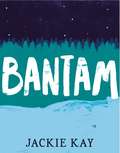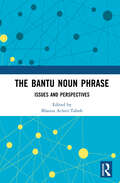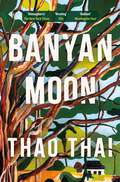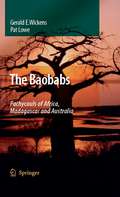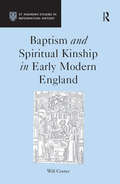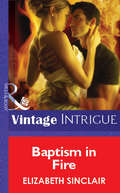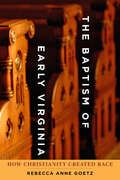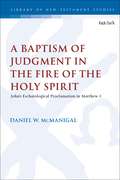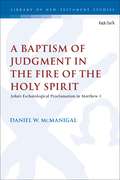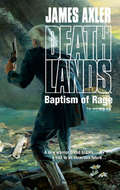- Table View
- List View
Bantam
by Jackie KayJackie Kay’s first collection as Scottish Makar is a book about the fighting spirit – one, the poet argues, that we need now more than ever. Bantam brings three generations into sharp focus – Kay’s own, her father’s, and his own father’s – to show us how the body holds its own story. Kay shows how old injuries can emerge years later; how we bear and absorb the loss of friends; how we celebrate and welcome new life; and how we how we embody our times, whether we want to or not. Bantam crosses borders, from Rannoch Moor to the Somme, from Brexit to Bronte country. Who are we? Who might we want to be? These are poems that sing of what connects us, and lament what divides us; poems that send daylight into the dark that threatens to overwhelm us – and could not be more necessary to the times in which we live.
BANTAM User Guide: Biometric and Token Technology Application Modeling Language
by Julian AshbournBANTAM is the first modeling language specifically designed for applications in Biometrics and Token Technology. It represents a significant step forward for the design and implementation of biometric and related technology applications in that:- it is very simple to learn and use;- it offers a consistent system of documentation and a clarity of presentation which make the accurate description of user requirements much easier;- it provides a complete methodology for managing the project from original business case, through procurement and implementation, to subsequent training and support."The User Guide" provides much more than just a guide to the Bantam methodology: readers will also find lots of good advice on program management in general and will gain an insight into designing biometric and related applications. It will be essential reading for anyone who is serious about biometrics and related technologies, including governmental/corporate end-users, systems integrators, biometric vendors, application developers and device manufacturers. It will also be useful background reading for advanced students and IT and management consultants.Reviews of Julian Ashbourn's first book: "Biometrics: Advanced Identity Verification":"You could attend a dozen conferences and not come away with the kind of overview presented in this new book".Dave Mintie, Connecticut Department of Social Services" a highly readable, entertaining guidebook that should serve as a welcome companion for anyone who must promote, explain, justify, or control an organization's transition to biometric technology."Richard Norton, Executive Director, International Biometrics Industry Association
Bantu Beliefs and Magic: with particular reference to the Kikuyu and Kamba tribes of Kenya colony; together with some reflections on east Africa after the war (Routledge Revivals)
by C. W. HobleyFirst published in 1922, the author of this book was for many years a Provincial Commissioner of what was then the Kenya Colony whose main objects were to place on record the results of investigations made among the native tribes in British East Africa, particularly among the Kikuyu and Kamba people, and to endeavour from a study of their ceremonial with regard to sacrifice and taboo, to obtain a better insight into the principles which underlie the outward forms and ceremonies of their ritual. Together with natural religion and magic, the author discusses a variety of social activities influenced by religious beliefs, such as the organisation of councils, ceremonial oaths, war and peace, dances, legends, and the position of women in tribal society. The functions of some of the practices are self-evident or can be explained within the limits of psychological or anthropological terms, whilst others remain unexplained and seem inexplicable, even futile. The author’s careful analysis of this last class provides interesting ethnological comment, for in seeking a better understanding of the psychology of one particular race, he draws attention also to analogous conditions of religious customs existing amongst other widely differing races. In the last chapter, ‘Quo Vadis’, added to the second edition of 1938, the author furthers his discussion of East Africa after the war. Together with the factual analysis of the first three parts, these additional observations, invaluable once to administrators and all concerned in colonial government, today prove their value not only for students of East Africa, but for all those endeavouring to arrive at an adjustment between the old native social structure and the extraneous forces now operating with ever increasing intensity.
Bantu Beliefs and Magic: with particular reference to the Kikuyu and Kamba tribes of Kenya colony; together with some reflections on east Africa after the war (Routledge Revivals)
by C. W. HobleyFirst published in 1922, the author of this book was for many years a Provincial Commissioner of what was then the Kenya Colony whose main objects were to place on record the results of investigations made among the native tribes in British East Africa, particularly among the Kikuyu and Kamba people, and to endeavour from a study of their ceremonial with regard to sacrifice and taboo, to obtain a better insight into the principles which underlie the outward forms and ceremonies of their ritual. Together with natural religion and magic, the author discusses a variety of social activities influenced by religious beliefs, such as the organisation of councils, ceremonial oaths, war and peace, dances, legends, and the position of women in tribal society. The functions of some of the practices are self-evident or can be explained within the limits of psychological or anthropological terms, whilst others remain unexplained and seem inexplicable, even futile. The author’s careful analysis of this last class provides interesting ethnological comment, for in seeking a better understanding of the psychology of one particular race, he draws attention also to analogous conditions of religious customs existing amongst other widely differing races. In the last chapter, ‘Quo Vadis’, added to the second edition of 1938, the author furthers his discussion of East Africa after the war. Together with the factual analysis of the first three parts, these additional observations, invaluable once to administrators and all concerned in colonial government, today prove their value not only for students of East Africa, but for all those endeavouring to arrive at an adjustment between the old native social structure and the extraneous forces now operating with ever increasing intensity.
The Bantu Noun Phrase: Issues and Perspectives
by Blasius Achiri-TabohThis collection of original essays addresses salient issues in a range of empirical and conceptual analyses, providing detailed case studies of phenomena in Bantu languages and robust and interesting discussions on the structure of the noun phrase. This volume speaks to contemporary debates on the Bantu noun phrase, seeking to stimulate a greater understanding of the true nature of adnominal modification, definiteness, and anaphoric relations associated with it, with respect to various segmental and supra-segmental, noun formation, and noun classification phenomena. The ten chapters take the reader through the Grassfields, North-Western, North-Eastern and Southern present-day Bantu homeland, making important contributions to the documentation and analysis of Bantu languages. The Bantu Noun Phrase: Issues and Perspectives is unique in its inclusion of so many North-Eastern Bantu languages in its discourse on Bantu linguistics and this important collection will be of particular interest to those researching, teaching, and studying African languages and linguistics.
The Bantu Noun Phrase: Issues and Perspectives
This collection of original essays addresses salient issues in a range of empirical and conceptual analyses, providing detailed case studies of phenomena in Bantu languages and robust and interesting discussions on the structure of the noun phrase. This volume speaks to contemporary debates on the Bantu noun phrase, seeking to stimulate a greater understanding of the true nature of adnominal modification, definiteness, and anaphoric relations associated with it, with respect to various segmental and supra-segmental, noun formation, and noun classification phenomena. The ten chapters take the reader through the Grassfields, North-Western, North-Eastern and Southern present-day Bantu homeland, making important contributions to the documentation and analysis of Bantu languages. The Bantu Noun Phrase: Issues and Perspectives is unique in its inclusion of so many North-Eastern Bantu languages in its discourse on Bantu linguistics and this important collection will be of particular interest to those researching, teaching, and studying African languages and linguistics.
The Bantu-Speaking Peoples of Southern Africa (Routledge Revivals)
by W. D. Hammond-TookeFirst published in 1974, The Bantu-Speaking Peoples of Southern Africa is a revised and rewritten version of I. Schapera’s ethnographical survey of the Bantu-speaking tribes of South Africa. New South African contributors place on record all the known facts of the physical characteristics and traditional cultures of these peoples, as well as documenting the important social, cultural and economic changes that have occurred since the coming of the white man. This book will be of interest to students of anthropology, sociology, African studies, and history.
The Bantu-Speaking Peoples of Southern Africa (Routledge Revivals)
First published in 1974, The Bantu-Speaking Peoples of Southern Africa is a revised and rewritten version of I. Schapera’s ethnographical survey of the Bantu-speaking tribes of South Africa. New South African contributors place on record all the known facts of the physical characteristics and traditional cultures of these peoples, as well as documenting the important social, cultural and economic changes that have occurred since the coming of the white man. This book will be of interest to students of anthropology, sociology, African studies, and history.
Banyan Moon
by Thao ThaiA READ WITH JENNA BOOK CLUB PICK"A riveting mother-daughter tale" - Elle"A joy to read" Christina Baker Kline, #1 New York Times bestselling author of The Exiles Ann Tran is already at a crossroads when she gets the call that her beloved grandmother, Minh, has died. Ann has built a seemingly perfect life. She lives in a beautiful lake house and has a charming professor boyfriend, but it all crumbles away with one positive pregnancy test. With both her relationship and carefully planned future now in question, Ann returns home to Florida to face her estranged mother, Hu'o'ng. Under the same roof for the first time in years, mother and daughter must face the simmering questions of their past, while trying to rebuild their relationship without the one person who's always held them together. Running parallel to this is Minh's story, as she goes from a lovestruck teenager living in the shadow of the Vietnam War to a determined young mother immigrating to America in search of a better life. And when Ann makes a shocking discovery in the Banyan House's attic, long-buried secrets come to light as it becomes clear how decisions Minh made in her youth affected the rest of her life and her family. Spanning decades and continents, from 1960s Vietnam to the wild swamplands of the Florida coast, Banyan Moon is a stunning and deeply moving story of mothers and daughters, the things we inherit, and the lives we choose to make out of that inheritance."Heart-shatteringly beautiful. Banyan Moon is a love letter to keepers of secrets, to motherhood, family and survival." - Nguyen Phan Que Mai, internationally bestselling author of The Mountains Sing and Dust Child.WHAT READERS ARE SAYING ABOUT BANYAN MOON'A wonderful debut novel' 5* Reader Review'A gorgeous and absorbing family saga' 5* Reader Review'This is an epic, sweeping debut from a writer who is definitely one to watch' 5* Reader Review
Bao
by Loretta LiuUnlock the potential of your bamboo steamer with 65 delicious recipes for Asian bites and street food style treats, from bao buns to dim sum. Bamboo steamers are at the heart of simple Asian cooking, producing everything from fluffy pork bao buns to steamed Chinese chicken. This collection of recipes will help you use this simple and effective cooking tool from ancient China to produce vibrant and tasty treats. Whip up ‘pillows of joy’ in delicious bao bun recipes and make fluffy, edible clouds of doughy yumminess that pack a sweet and savoury punch in one hit, alongside a range of other dumplings and Asian street foods. Steamed chicken, fish, vegetables and sticky rice have never been easier to whip up. Unlock a whole new world of Asian cooking with these recipes, and discover the incredible flavours and textures that can be created in your bamboo steamer.
Bao Ninh's Contribution to Vietnamese and World Literature: "The Sorrow of War" and his Short Stories (Routledge Research on Asian Literature)
by Cao Kim Lan Ooi GinBao Ninh's Contribution to Vietnamese and World Literature analyzes and presents the works of Bao Ninh, the most well-known writer in modern Vietnamese literature. His works are renowned both in Vietnam and worldwide and his novel The Sorrow of War, which has been translated into more than 15 languages, is considered to be one of the classic works of war literature.This book by two award-winning scholars, one in war literature and the other in war history, presents for the first time an overall assessment of Bao Ninh’s works, notably of his celebrated novel and his short stories. It outlines his life, setting it in the context of war-torn Vietnam whence he was a teenage soldier at the age of 17 in the North Vietnamese People's Army (NVPA); highlights the main themes of the corpus of his writings, inter alia of suffering and trauma of war impacts of post-traumatic stress disorder (PTSD) of veterans, of the futility of war; discusses his approach to writing; compares his writings with others in war literature; and examines and assesses his especial place in world literature. This pioneering monograph of the scholarly evaluation of Bao Ninh himself and his works further engages in the discourse of his contribution to modern Vietnamese literature and world literature. Encouraging a better understanding of wars and conflicts, the book will be of interest to researchers and students in the fields of modern Asian history, in particular the Vietnam War, Southeast Asian Studies, and Vietnamese and World literature.
Bao Ninh's Contribution to Vietnamese and World Literature: "The Sorrow of War" and his Short Stories (Routledge Research on Asian Literature)
by Cao Kim Lan Ooi GinBao Ninh's Contribution to Vietnamese and World Literature analyzes and presents the works of Bao Ninh, the most well-known writer in modern Vietnamese literature. His works are renowned both in Vietnam and worldwide and his novel The Sorrow of War, which has been translated into more than 15 languages, is considered to be one of the classic works of war literature.This book by two award-winning scholars, one in war literature and the other in war history, presents for the first time an overall assessment of Bao Ninh’s works, notably of his celebrated novel and his short stories. It outlines his life, setting it in the context of war-torn Vietnam whence he was a teenage soldier at the age of 17 in the North Vietnamese People's Army (NVPA); highlights the main themes of the corpus of his writings, inter alia of suffering and trauma of war impacts of post-traumatic stress disorder (PTSD) of veterans, of the futility of war; discusses his approach to writing; compares his writings with others in war literature; and examines and assesses his especial place in world literature. This pioneering monograph of the scholarly evaluation of Bao Ninh himself and his works further engages in the discourse of his contribution to modern Vietnamese literature and world literature. Encouraging a better understanding of wars and conflicts, the book will be of interest to researchers and students in the fields of modern Asian history, in particular the Vietnam War, Southeast Asian Studies, and Vietnamese and World literature.
Baobab: The Hadza of Tanzania and the Baobab as Humanity's Tree of Life
by John RashfordModern humans, descendants of a founding population that separated from chimpanzees some five to eight million years ago, are today the only living representative of a branching group of African apes called hominins. Because of its extraordinary size and shape, the baobab (Adansonia digitata L.) has long been identified as the most striking tree of Africa’s mosaic savanna, the landscape generally regarded as the environment of hominin evolution. This book makes the case for identifying the baobab as the tree of life in the hunter-gatherer adaptation that was the economic foundation of hominin evolution. The argument is based on the significance of the baobab as a resource-rich environment for the Hadza of northeastern Tanzania, who continue to be successful hunter-gatherers of the African savanna.
The Baobabs: Pachycauls of Africa, Madagascar and Australia
by G.E. WickensThis is the only comprehensive account of all eight species in the genus Adansonia. It describes the historical background from the late Roman period to the present. It covers the extraordinary variety of economic uses of baobabs. There are also appendices on vernacular names, gazetteer, economics, nutrition and forest mensuration. This book fills a gap in the botanical literature. It deals with a genus that has fascinated and intrigued scientists and lay persons for centuries.
Baptism: An Ed Mallory Thriller
by Max Kinnings07:45am. A monk lies dead in Snowdonia, a knife protruding from his throat. A young family is being held at gunpoint in a house in Wimbledon. The mission has begun. 08:56am. A London Underground train is stationary in a tunnel, four hundred passengers trapped inside. All efforts to communicate with it have been met with silence. 09:15am. DCI Ed Mallory has just started his day. The Met's top hostage negotiator - despite having been blinded thirteen years earlier - Mallory is about to discover that, today, an underground train is not the only thing on the line.
Baptism and Spiritual Kinship in Early Modern England (St Andrews Studies in Reformation History)
by Will CosterDespite the importance of the subject to contemporaries, this is the first monograph to look at the institution of godparenthood in early modern English society. Utilising a wealth of hitherto largely neglected primary source data, this work explores godparenthood, using it as a framework to illuminate wider issues of spiritual kinship and theological change. It has become increasingly common for general studies of family and religious life in pre-industrial England to make reference to the spiritual kinship evident in the institution of godparenthood. However, although there have been a number of important studies of the impact of the institution in other periods, this is the first detailed monograph devoted to the subject in early modern England. This study is possible due to the survival, contrary to many expectations, of relatively large numbers of parish registers that recorded the identities of godparents in the sixteenth and seventeenth centuries. By utilising this hitherto largely neglected data, in conjunction with evidence gleaned from over 20,000 Wills and numerous other biographical, legal and theological sources, Coster has been able to explore fully the institution of godparenthood and the role it played in society. This book takes the opportunity to study an institution which interacted with a range of social and cultural factors, and to assess the nature of these elements within early modern English society. It also allows the findings of such an investigation to be compared with the assumptions that have been made about the fortunes of the institution in the context of a changing European society. The recent historiography of religion in this period has focused attention on popular elements of religious practice, and stressed the conservatism of a society faced with dramatic theological and ritual change. In this context a study of godparenthood can make a contribution to understanding how religious change occurred and the ways in which popular religious practice was affected.
Baptism and Spiritual Kinship in Early Modern England (St Andrews Studies in Reformation History)
by Will CosterDespite the importance of the subject to contemporaries, this is the first monograph to look at the institution of godparenthood in early modern English society. Utilising a wealth of hitherto largely neglected primary source data, this work explores godparenthood, using it as a framework to illuminate wider issues of spiritual kinship and theological change. It has become increasingly common for general studies of family and religious life in pre-industrial England to make reference to the spiritual kinship evident in the institution of godparenthood. However, although there have been a number of important studies of the impact of the institution in other periods, this is the first detailed monograph devoted to the subject in early modern England. This study is possible due to the survival, contrary to many expectations, of relatively large numbers of parish registers that recorded the identities of godparents in the sixteenth and seventeenth centuries. By utilising this hitherto largely neglected data, in conjunction with evidence gleaned from over 20,000 Wills and numerous other biographical, legal and theological sources, Coster has been able to explore fully the institution of godparenthood and the role it played in society. This book takes the opportunity to study an institution which interacted with a range of social and cultural factors, and to assess the nature of these elements within early modern English society. It also allows the findings of such an investigation to be compared with the assumptions that have been made about the fortunes of the institution in the context of a changing European society. The recent historiography of religion in this period has focused attention on popular elements of religious practice, and stressed the conservatism of a society faced with dramatic theological and ritual change. In this context a study of godparenthood can make a contribution to understanding how religious change occurred and the ways in which popular religious practice was affected.
Baptism, Brotherhood, and Belief in Reformation Germany: Anabaptism and Lutheranism, 1525-1585 (Oxford Historical Monographs)
by Kat HillWhen Martin Luther mounted his challenge to the Catholic Church, reform stimulated a range of responses, including radical solutions such as those proposed by theologians of the Anabaptist movement. But how did ordinary Anabaptists, men and women, grapple with the theological and emotional challenges of the Lutheran Reformation? Anabaptism developed along unique lines in the Lutheran heartlands in central Germany, where the movement was made up of scattered groups and did not centre on charismatic leaders as it did elsewhere. Ideas were spread more often by word of mouth than by print, and many Anabaptists had uneven attachment to the movement, recanting and then relapsing. Historiography has neglected Anabaptism in this area, since it had no famous leaders and does not seem to have been numerically strong. Baptism, Brotherhood, and Belief challenges these assumptions, revealing how Anabaptism's development in central Germany was fundamentally influenced by its interaction with Lutheran theology. In doing so, it sets a new agenda for understandings of Anabaptism in central Germany, as ordinary individuals created new forms of piety which mingled ideas about brotherhood, baptism, the Eucharist, and gender and sex. Anabaptism in this region was not an isolated sect but an important part of the confessional landscape of the Saxon lands, and continued to shape Lutheran pastoral affairs long after scholarship assumed it had declined. The choices these Anabaptist men and women made sat on a spectrum of solutions to religious concerns raised by the Reformation. Understanding their decisions, therefore, provides new insights into how religious identities were formed in the Reformation era.
Baptism In Fire (Mills And Boon Vintage Intrigue Ser.)
by Elizabeth SinclairTheir marriage had gone up in flames the night Detective Luke Sutherland and arson investigator Rachel Lansing's home burned down–and their daughter disappeared in a mystery of fire and smoke. Now, the firebug was back.
The Baptism of Early Virginia: How Christianity Created Race (Early America: History, Context, Culture)
by Rebecca Anne GoetzIn The Baptism of Early Virginia, Rebecca Anne Goetz examines the construction of race through the religious beliefs and practices of English Virginians. She finds the seventeenth century a critical time in the development and articulation of racial ideologies—ultimately in the idea of "hereditary heathenism," the notion that Africans and Indians were incapable of genuine Christian conversion. In Virginia in particular, English settlers initially believed that native people would quickly become Christian and would form a vibrant partnership with English people. After vicious Anglo-Indian violence dashed those hopes, English Virginians used Christian rituals like marriage and baptism to exclude first Indians and then Africans from the privileges enjoyed by English Christians—including freedom.Resistance to hereditary heathenism was not uncommon, however. Enslaved people and many Anglican ministers fought against planters’ racial ideologies, setting the stage for Christian abolitionism in the late eighteenth and early nineteenth centuries. Using court records, letters, and pamphlets, Goetz suggests new ways of approaching and understanding the deeply entwined relationship between Christianity and race in early America.
The Baptism of Early Virginia: How Christianity Created Race (Early America: History, Context, Culture)
by Rebecca Anne GoetzIn The Baptism of Early Virginia, Rebecca Anne Goetz examines the construction of race through the religious beliefs and practices of English Virginians. She finds the seventeenth century a critical time in the development and articulation of racial ideologies;¢;‚¬;€?ultimately in the idea of "hereditary heathenism," the notion that Africans and Indians were incapable of genuine Christian conversion. In Virginia in particular, English settlers initially believed that native people would quickly become Christian and would form a vibrant partnership with English people. After vicious Anglo-Indian violence dashed those hopes, English Virginians used Christian rituals like marriage and baptism to exclude first Indians and then Africans from the privileges enjoyed by English Christians;¢;‚¬;€?including freedom.Resistance to hereditary heathenism was not uncommon, however. Enslaved people and many Anglican ministers fought against planters;€™ racial ideologies, setting the stage for Christian abolitionism in the late eighteenth and early nineteenth centuries. Using court records, letters, and pamphlets, Goetz suggests new ways of approaching and understanding the deeply entwined relationship between Christianity and race in early America.
Baptism of Fire: Witcher 3 – Now a major Netflix show (The Witcher #5)
by Andrzej SapkowskiGeralt of Rivia is on a mission to save his ward, Ciri, and with her the world, in this third novel in the bestselling Witcher series that inspired the Netflix show and video games. The Wizards Guild has been shattered by a coup and, in the uproar, Geralt was seriously injured. The Witcher is supposed to be a guardian of the innocent, a protector of those in need, a defender against powerful and dangerous monsters that prey on men in dark times.But now that dark times have fallen upon the world, Geralt is helpless until he has recovered from his injuries.While war rages across all of the lands, the future of magic is under threat and those sorcerers who survive are determined to protect it. It's an impossible situation in which to find one girl - Ciri, the heiress to the throne of Cintra, has vanished - until a rumour places her in the Niflgaard court, preparing to marry the Emperor. Injured or not, Geralt has a rescue mission on his hands.Translated by David French.
A Baptism of Judgment in the Fire of the Holy Spirit: John’s Eschatological Proclamation in Matthew 3 (The Library of New Testament Studies)
by Daniel W. McManigalDaniel W. McManigal provides a fresh analysis of the meaning of the baptism in the Holy Spirit and fire, and John's baptism as a prophetic sign-act. Expanding upon the sources, grammar and meaning of the Logion, analysing Old Testament and Second Temple texts, and discussing the prevalent theme of judgment in baptism, McManigal offers the first extended treatment of the baptism in the Holy Spirit in Matthew's gospel. As a backdrop for the prevalence of judgment in baptism, McManigal locates Matthew's eschatological judgment within the broader Old Testament and apocalyptic literature of the Second Temple, drawing upon texts such as Isaiah 11 and the Isaiah Targum, Malachi 3, Daniel 7, 1 Enoch and 4 Ezra. This volume's analysis aids deeper understanding of how the themes of the Old Testament are woven throughout Matthew's narrative, capitalizing on John's role as the last of the prophets sent to Israel; McManigal focuses in particular on Matthew's foretelling the coming of the Messiah, and his call for repentance in order to prepare people for the arrival of the kingdom of God. Drawing out the unique Matthean meaning of the baptism of the “coming one,” McManigal's study offers readers a new insight into the nature of repenting and prophetic baptism, whether through water, fire or Spirit.
A Baptism of Judgment in the Fire of the Holy Spirit: John’s Eschatological Proclamation in Matthew 3 (The Library of New Testament Studies)
by Daniel W. McManigalDaniel W. McManigal provides a fresh analysis of the meaning of the baptism in the Holy Spirit and fire, and John's baptism as a prophetic sign-act. Expanding upon the sources, grammar and meaning of the Logion, analysing Old Testament and Second Temple texts, and discussing the prevalent theme of judgment in baptism, McManigal offers the first extended treatment of the baptism in the Holy Spirit in Matthew's gospel. As a backdrop for the prevalence of judgment in baptism, McManigal locates Matthew's eschatological judgment within the broader Old Testament and apocalyptic literature of the Second Temple, drawing upon texts such as Isaiah 11 and the Isaiah Targum, Malachi 3, Daniel 7, 1 Enoch and 4 Ezra. This volume's analysis aids deeper understanding of how the themes of the Old Testament are woven throughout Matthew's narrative, capitalizing on John's role as the last of the prophets sent to Israel; McManigal focuses in particular on Matthew's foretelling the coming of the Messiah, and his call for repentance in order to prepare people for the arrival of the kingdom of God. Drawing out the unique Matthean meaning of the baptism of the “coming one,” McManigal's study offers readers a new insight into the nature of repenting and prophetic baptism, whether through water, fire or Spirit.
Baptism Of Rage
by James AxlerThe end of the world arrived in a nuclear rush, forging the agonized remains of past and present into a new reality known as Deathlands. Now life is a simple series of rules of survival, where having is better than not having–and anything is worth killing for.
